A Long Way To Freedom: Banned Photos From Poland's 1980s
Joy after the August agreements, oppressive martial law, and punk freedom in Jarocin. Karta Centre’s unseen photographic collection captures the volatile 1980s when Poles were fiercely determined to attain freedom and democracy.
The last decade of the communist regime in Poland was rich in events that strongly influenced the socio-political situation of the country and Europe itself. In spite of omnipresent censorship, Poles tried to aptly illustrate the changing reality and to uncover the hypocrisy of the authorities. The following photographs were included in the Karta Centre’s collections presented in late 2017 during the Imperatyw exhibition. Most were commissioned by foreign news agencies and were previously unpublished.
A wave of strikes
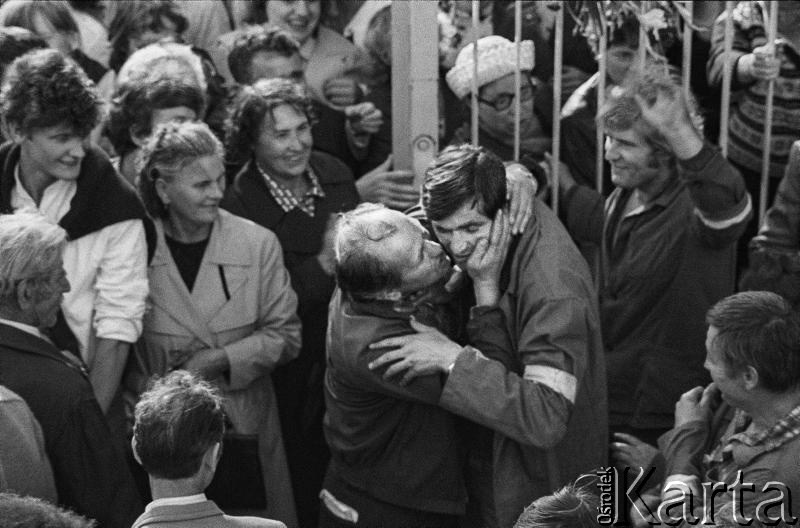 31st August 1980, Gdańsk, the termination of the strike in the Lenin Shipyard, photo: Witold Górka / Karta Centre
31st August 1980, Gdańsk, the termination of the strike in the Lenin Shipyard, photo: Witold Górka / Karta CentreAugust 1980 was one of the breakthrough moments in the history of Poland’s communist regime and one of the founding myths of the democratic opposition. After protests in Świdnik and Lublin, the Free Trade Unions of the Coast joined the strike. The workers demanded, amongst other things, the reinstatement of the welder Anna Walentynowicz (fired for being a key member of the opposition), a pay rise, and a new monument dedicated to the victims of the 1970 protests in northern Poland.
A few days later on 17th August, the Inter-Enterprise Strike Committee announced a total of 21 demands, including the possibility of registering free trade unions, freedom to strike and freedom of speech.
The photo here depicts behind-the-scenes of the end of the strike in the Gdańsk Shipyard. Its participants are ecstatic, the government backed out, the agreements were signed. The August events marked the beginning of a relative détente in Poland which lasted for nearly 15 months before ending brutally with the introduction of Martial Law.
Détente
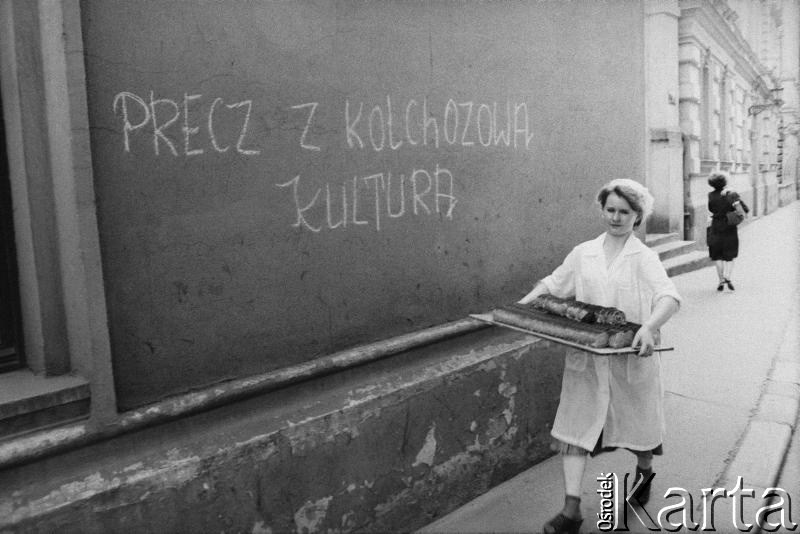 Autumn 1981, Kraków, Pijarska Street, photo: Piotr Dylik / Karta Centre
Autumn 1981, Kraków, Pijarska Street, photo: Piotr Dylik / Karta CentreThe authorities buckled under immense social pressure and showed weakness. Criticism started revealing itself, and more and more people, encouraged by the lack of reaction from the government, joined the Solidarność labour union. Graffiti was just one of the forms of social resistance.
Martial law
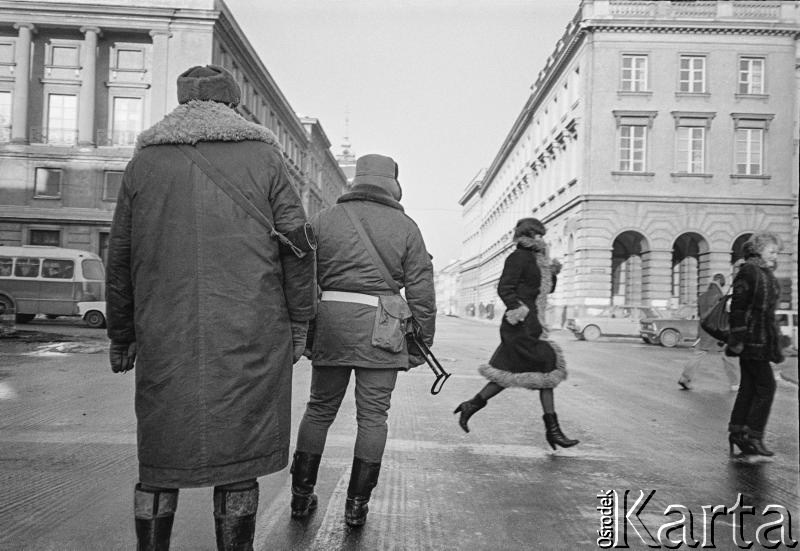 After 13th December 1981, Warsaw; militiamen on the intersection of Świętokrzyska and Nowy Świat streets, photo: Małgorzata Niezabitowska & Tomasz Tomaszewski / Karta Centre
After 13th December 1981, Warsaw; militiamen on the intersection of Świętokrzyska and Nowy Świat streets, photo: Małgorzata Niezabitowska & Tomasz Tomaszewski / Karta Centre
The short-lived détente ended on 13th December 1981, when martial law was proclaimed throughout the entire country.
Tomasz Tomaszewski, a journalist, and Małgorzata Niezabitowska, his wife, took extraordinary photos during the Martial Law period. They wandered around Warsaw in big Soviet wool coats with a camera hidden in a specially-prepared glove that had a hole cut out for the lens. The journalist recalls:
When my wife told me ‘Nobody’s looking at you,’ I would take a photo.
Each photo was taken in insecurity and stress. The couple masked the sound of the camera by coughing or pretending to talk. ‘If they had caught me, I would’ve gotten at least 5 years,’ the photographer explains. Tomaszewski’s works and Niezabitowska ’s specially-prepared secret journal were smuggled to the West and then appeared in the Italian and French press.
The photos and excerpts from the journal were published in the book W Twoim Kraju Wojna (The War in Your Country) in 2016 by the Karta Centre.
Internment
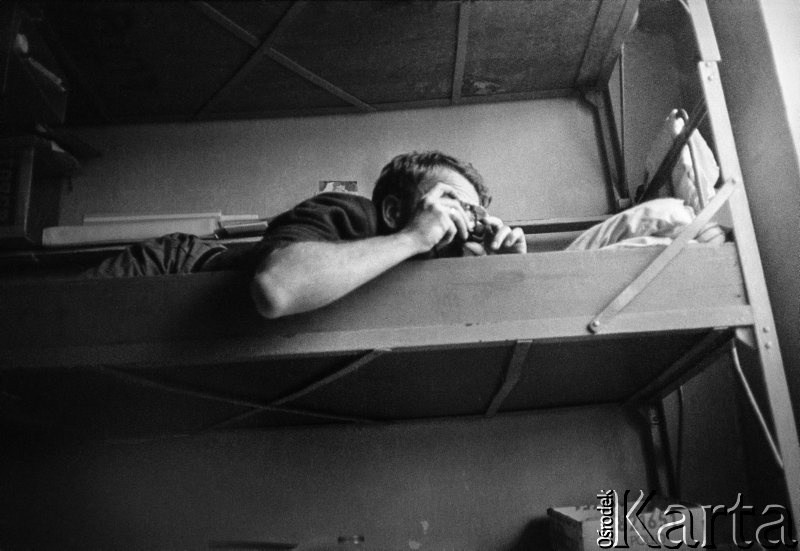 May-July 1982, Warsaw; Maciej Kwiatkowski in an internment centre in Białołęka, photo: Andrzej Zieliński / Karta Centre
May-July 1982, Warsaw; Maciej Kwiatkowski in an internment centre in Białołęka, photo: Andrzej Zieliński / Karta Centre
During Martial Law, approximately 10,000 Solidarność activists were deemed dangerous by the Military Council of National Salvation and interned.
The leaders of Solidarność were jailed in the Białołęka district in Warsaw, apart from Lech Wałęsa, who was transported to Arłamów in south-eastern Poland. The facility was installed within a prison. Between 1981 and 1982, approximately 600 representatives from the democratic opposition were held there.
Marek Nowicki, the late director of the Helsinki Foundation for Human Rights, said many years later:
We didn’t fight for victory, we fought for what was our duty. The time I spent in that prison was a time of high personal dignity.
We were able to smuggle small objects into the prison – a camera was one of them.
Repressions
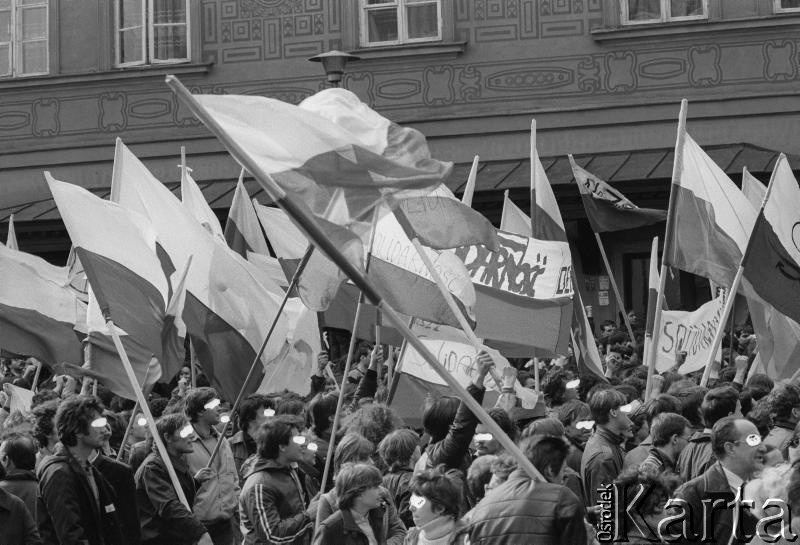
3rd May 1982, Warsaw, an independent demonstration at the Old Town, photo: Maciej Czarnocki / Karta Centre
The police state tried to suppress the focal points of protest and isolate or directly hurt political opponents. ZOMO, the armed unit of the Civic Militia, was a tool in the hands of the authorities.
The security forces faced the strongest protest to Martial Law in the coal mines of the Silesia region. An especially tragic event was the massacre of striking miners in the Wujek mine in Katowice on 16th December 1981. A special unit of ZOMO killed 9 miners and injured a further 23.
Although the authorities used violence, demonstrations were still held. Maciej Czarnocki photographed one such event. He didn’t want to endanger its participants, so he scratched their faces off the photos.
Freedom!
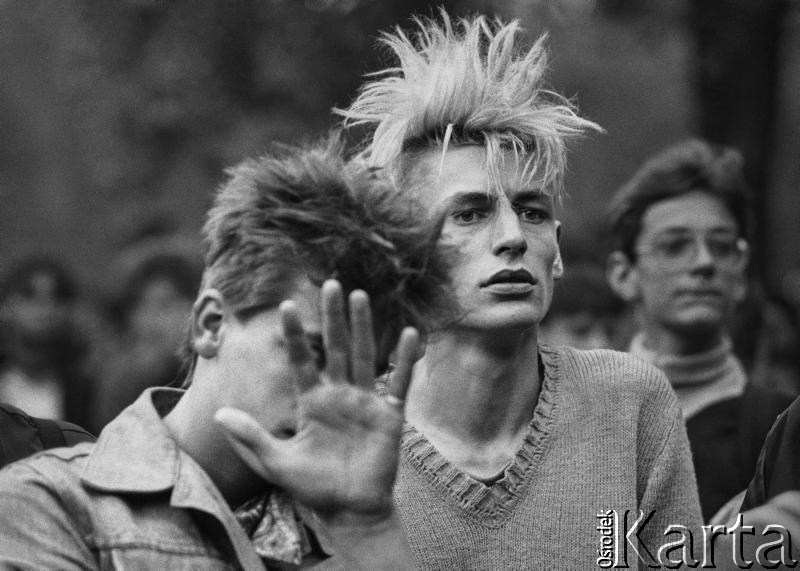 29th July – 2nd August 1986, a rock festival in Jarocin, photo: Wojciech Druszcz / Karta Centre
29th July – 2nd August 1986, a rock festival in Jarocin, photo: Wojciech Druszcz / Karta Centre
‘You could feel a bond among people and a need for freedom,’ recalls journalist Wojciech Druszcz when talking about Jarocin. The small town would liven up each year with the arrival of a rock festival. It was an opportunity to show one’s dissatisfaction. Protest was expressed through clothes, hairstyles and behaviour.
According to some theories, Jarocin was a safety valve staged by the authorities to quell the frustrated youth, but one cannot deny the power of the new anthems that appeared, which were later spread via cassettes. Several important debuts were made here, including Siekiera, Dezerter, Dżem, TSA and Armia.
More photos from the last decade of the communist regime are available on this website.
Originally written in Polish, translated by AP, May 2018
[{"nid":"5688","uuid":"6aa9e079-0240-4dcb-9929-0d1cf55e03a5","type":"article","langcode":"en","field_event_date":"","title":"Challenges for Polish Prose in the Nineties","field_introduction":"Content: Depict the world, oneself and the form | The Mimetic Challenge: seeking the truth, destroying and creating myths | Seeking the Truth about the World | Destruction of the Heroic Emigrant Myth | Destruction of the Polish Patriot Myth | Destruction of the Flawless Democracy Myth | Creation of Myths | Biographical challenge | Challenges of genre | Summary\r\n","field_summary":"Content: Depict the world, oneself and the form | The Mimetic Challenge: seeking the truth, destroying and creating myths | Seeking the Truth about the World | Destruction of the Heroic Emigrant Myth | Destruction of the Polish Patriot Myth | Destruction of the Flawless Democracy Myth | Creation of Myths | Biographical challenge | Challenges of genre | Summary","topics_data":"a:2:{i:0;a:3:{s:3:\u0022tid\u0022;s:5:\u002259609\u0022;s:4:\u0022name\u0022;s:26:\u0022#language \u0026amp; literature\u0022;s:4:\u0022path\u0022;a:2:{s:5:\u0022alias\u0022;s:27:\u0022\/topics\/language-literature\u0022;s:8:\u0022langcode\u0022;s:2:\u0022en\u0022;}}i:1;a:3:{s:3:\u0022tid\u0022;s:5:\u002259644\u0022;s:4:\u0022name\u0022;s:8:\u0022#culture\u0022;s:4:\u0022path\u0022;a:2:{s:5:\u0022alias\u0022;s:14:\u0022\/topic\/culture\u0022;s:8:\u0022langcode\u0022;s:2:\u0022en\u0022;}}}","field_cover_display":"default","image_title":"","image_alt":"","image_360_auto":"\/sites\/default\/files\/styles\/360_auto\/public\/2018-04\/jozef_mroszczak_forum.jpg?itok=ZsoNNVXJ","image_260_auto":"\/sites\/default\/files\/styles\/260_auto_cover\/public\/2018-04\/jozef_mroszczak_forum.jpg?itok=pLlgriOu","image_560_auto":"\/sites\/default\/files\/styles\/560_auto\/public\/2018-04\/jozef_mroszczak_forum.jpg?itok=0n3ZgoL3","image_860_auto":"\/sites\/default\/files\/styles\/860_auto\/public\/2018-04\/jozef_mroszczak_forum.jpg?itok=ELffe8-z","image_1160_auto":"\/sites\/default\/files\/styles\/1160_auto\/public\/2018-04\/jozef_mroszczak_forum.jpg?itok=XazO3DM5","field_video_media":"","field_media_video_file":"","field_media_video_embed":"","field_gallery_pictures":"","field_duration":"","cover_height":"991","cover_width":"1000","cover_ratio_percent":"99.1","path":"en\/node\/5688","path_node":"\/en\/node\/5688"}]